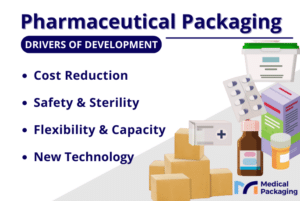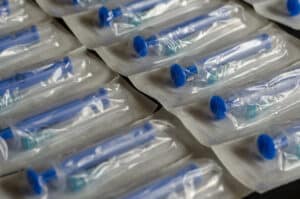The Development of Pharmaceutical Packaging in Today’s Care Markets
What Is Pharmaceutical Packaging?
Pharmaceutical packaging refers to the process, materials, designs, and systems that package, label, and distribute drugs in a variety of healthcare markets.
With such a highly regulated industry, healthcare organizations and pharmacies must use specific packaging that meets the requirements set by regulatory authorities in the United States, such as the Food and Drug Administration (FDA).
These regulations, along with recent trends and changes in the healthcare industry, have led to increasing demand for safe, efficient, and sustainable packaging.
Manufacturers focus on meeting these demands by optimizing the packaging materials and equipment that play a part in the packaging process. Let’s take a closer look at the development of the industry, as well as the solutions pharmaceutical packaging manufacturers bring to the market.
How to Optimize the Packaging Process?
Improving pharmaceutical packaging requires more than just new materials. It’s about building a system that reduces costs, increases safety, and complies with strict regulatory guidelines.
Manufacturers and healthcare organizations focus on:
- Conducting market research to identify the needs of pharmacies, hospitals, and long-term care facilities.
- Choosing automation-friendly equipment that speeds up production without compromising safety.
- Using high-quality, compliant materials that extend shelf life and prevent contamination.
- Designing clear, accurate labeling systems that support both caregivers and patients.
- Validating processes through testing and compliance checks to meet FDA and DSCSA standards.
Whether you’re packaging oral solids, liquids, or injectables, the goal remains the same: maintain quality and safety while improving operational efficiency.

Drivers of Development in the Pharmaceutical Packaging Market
The pharmaceutical packaging market is evolving quickly due to a mix of industry demands, technology, and regulatory shifts. Below are four external factors pushing innovation forward:
1. Cost Reduction
Pharmaceutical companies are under pressure to reduce costs while maintaining safety and compliance. Packaging manufacturers are expected to deliver efficient solutions that lower material use, minimize waste, and support automation to improve profitability.
2. Safety and Sterility
Medication packaging must protect against contamination, tampering, and degradation. With growing attention on sterile packaging environments, companies are investing in barrier-proof materials, tamper-evident features, and single-use formats to enhance patient safety.
3. Flexibility and Capacity
The rise of personalized medicine has made flexibility a must. Facilities now need packaging systems that can handle fluctuating volumes, smaller batch sizes, and unit-dose formats—all while keeping workflows efficient.
4. Smart and Connected Packaging
Technology is transforming pharmaceutical packaging. Features like RFID chips, 2D barcodes, and sensors help track medications throughout the supply chain. These tools also support compliance with serialization requirements like those introduced under the DSCSA.
Types of Drug Packaging
Pharmaceutical product packaging can be classified under three levels: Primary, secondary, and tertiary. The type of packaging and relevant stakeholders will depend on where in the distribution process you find a specific medication.
Primary Packaging
Primary packaging directly holds the medication. It protects the drug from contamination and environmental factors, while also supporting accurate dosing and safe handling.
Different types of primary packaging include:
- Blister packs
- Prefilled syringes
- Vials
- Plastic bottles
This level of packaging must meet U.S. regulatory requirements for safety and labeling. Labels include dosage, expiration, patient info, and product identification to reduce errors and support traceability.
Secondary Packaging
Secondary packaging groups multiple primary packages. It helps organize medications for storage and shipment within a facility.
- Boxes
- Cartons
- Injection trays
- Shipping containers
This layer adds protection and keeps medications organized, especially for hospitals or pharmacies managing large inventories.
Tertiary Packaging
Tertiary packaging is used to ship medications in bulk, typically from manufacturers to distributors or large healthcare providers.
Typical Packaging Includes:
- Large shipping containers
- Barrels
- Edge protectors and other packaging that help cushion packages as needed
This level ensures secure transport, protects against damage during handling, and facilitates easier logistics for high-volume orders.
MPI’s Packaging Solutions
Since 1971, MPI has provided high-quality pharmaceutical packaging systems built for safety, speed, and compliance. Our technology supports a wide range of care settings—including hospitals, long-term care facilities, and repackaging pharmacies.
We offer packaging solutions for oral solids, oral liquids, labeling, and overwrapping, all designed to meet current FDA and DSCSA standards.
Oral Solid Packaging Systems
- Auto-Print®: This barcode and packaging system can package at speeds of 60-unit dose packages per minute.
- Express 90: This packaging system can package at speeds of 90-unit doses of oral solid medications per minute.
- Oral Solid Feeder Attachment: This is used to load bulk medication into the feeder for improved speed and efficiency.
- Canister Feeder Attachment: This attachment fills prescription dose medications using canisters.
Oral Liquid Packaging Systems
- Fluidose®: This unit dose packaging system can fill and seal liquid medication at 22 doses per minute.
- Auto-Draw®: This oral syringe filling system provides improved accuracy in dose packaging for liquid medications.
- FD-Pharma®: This oral liquid cup packaging system is designed for managing lower to full production volumes.
Overwrapping Systems
- Pharmacy Accessory Bagging System: This system handles barcoding for packaging and can seal up to 35 bags in a minute.
- Auto-Print® Max Bagger: This system can fill 30 bags per minute with the use of automation technology.
Labeling Systems
- Auto-Wrap®: This machine can wrap a label around a syringe at the rate of up to 20 syringes per minute, resulting in greater speed and efficiency.
- Pharmacy Accessory Label Printer: This system can print barcodes and labels for a wide range of packaging, including vials and ampoules.
These systems are engineered to improve workflow, reduce labeling errors, and help meet short-cycle dispensing models in long-term care and specialty pharmacy environments.
How the Unit Dose Supply Method Has Advanced the Industry

Unit dose packaging delivers one dose of medication in a ready-to-administer format. This approach helps reduce medication errors, improve tracking, and save time for healthcare professionals.
Today, unit dose packaging is the standard across hospitals, long-term care facilities, and repackagers. It supports:
- Improved medication accuracy
- Faster administration times
- Compliance with CMS and DSCSA regulations
MPI’s systems are built specifically for this method, offering speed, precision, and compatibility with barcode labeling. To learn more, check out our blog post: Understanding the Unit Dose Supply Method.
Relevant Care Settings

Pharmaceutical packaging is used in a wide range of care markets in the healthcare industry, from hospitals to specialty pharmacies. The development of packaging requires pharmaceutical packaging manufacturers to meet all requirements and regulations for medications that are sent to various care settings.
Hospitals, Acute Care Facilities, & IDNs
Large facilities often manage high medication volumes and complex workflows. Efficient packaging systems help streamline operations, reduce delays, and support accurate administration across departments. MPI’s oral solid and liquid packaging systems are designed to keep up with these demands.
Long-Term Care and Extended Care Facilities
Packaging in LTC and EC facilities often focuses on individualized, small-batch doses. Pharmacies serving these facilities need compliant systems that support CMS-mandated short-cycle dispensing. MPI’s compact, high-accuracy packaging and labeling solutions are ideal for these environments.
Pharmaceutical Repackagers
Repackagers must meet strict FDA and DSCSA guidelines for sterile packaging. MPI’s equipment and materials are validated for safe, reliable use—helping simplify compliance while maintaining productivity and consistency across packaging runs.
Specialty Pharma
Specialty drug manufacturers and contract development and manufacturing organizations (CDMOs) often handle high-value or complex drugs like biologics. These medications require packaging systems that support traceability, temperature control, and customization. MPI systems help manage these requirements while reducing risk.
Trends in Packaging

As of November 27, 2024, the Drug Supply Chain Security Act (DSCSA) is now fully implemented. These regulatory standards require pharmaceutical manufacturers, wholesale distributors, dispensers, and repackagers to exchange serialized data electronically to improve traceability and reduce counterfeit drugs in the supply chain.
To stay competitive and compliant, pharmaceutical companies are now focused on:
- Digital traceability through 2D barcodes, RFID chips, and cloud-based data sharing
- Automation and robotics that streamline repetitive packaging tasks, improve accuracy, and reduce operational costs
- Eco-friendly materials like recyclable plastics, compostable films, and reusable secondary packaging to support environmental goals
- Patient-centered packaging with easy-open designs and medication adherence features tailored to seniors and long-term care populations
- These trends reflect a growing commitment to safety, efficiency, sustainability, and user experience across the entire pharmaceutical supply chain.
Staying on top of DSCSA regulatory compliance is now a core part of maintaining patient safety and operational efficiency.
Why Partner with MPI for Pharmaceutical Packaging?
MPI supports pharmacies, hospitals, and manufacturers with efficient, compliant packaging solutions backed by decades of experience. Our systems are trusted across the industry for their speed, safety, and reliability.
We also hold an FDA-accepted Type III Drug Master File, which allows our packaging systems to be easily referenced in regulatory submissions like NDAs and ANDAs—helping you get to market faster. This DMF gives our clients the ability to reference MPI’s validated packaging solutions in their regulatory filings without disclosing proprietary information.
As a result, we help expedite New Drug Applications (NDAs) and Abbreviated New Drug Applications (ANDAs), reducing time to market and supporting smoother FDA reviews. Our DMF also allows us to provide better technical support, maintain compliance, and meet evolving regulatory expectations across the pharmaceutical industry.
Have questions about optimizing your pharmaceutical packaging process? Our team is here to help. Whether you’re running a hospital pharmacy, serving long-term care facilities, or managing high-volume production, we’ll guide you to the right solution. Contact MedPak today!
Resources
MH2U. “3 Levels of the Pharmaceutical Packaging System.” LinkedIn, 13 Oct. 2022, www.linkedin.com/pulse/3-levels-pharmaceutical-packaging-system-mh2u/.
Author links open overlay panelKeisheni Ganeson a, et al. “Smart Packaging − a Pragmatic Solution to Approach Sustainable Food Waste Management.” Food Packaging and Shelf Life, Elsevier, 7 Feb. 2023, www.sciencedirect.com/science/article/abs/pii/S2214289423000212.
Content
- What Is Pharmaceutical Packaging?
- How to Optimize the Packaging Process?
- Drivers of Development in the Pharmaceutical Packaging Market
- Types of Drug Packaging
- MPI’s Packaging Solutions
- How the Unit Dose Supply Method Has Advanced the Industry
- Relevant Care Settings
- Trends in Packaging
- Why Partner with MPI for Pharmaceutical Packaging?
- Resources
Contact MPI Today for Personal Assistance
MPI’s Drug Master File provides speed-to-market regulatory and technical support related to our packaging components for medical and pharmaceutical market clients
